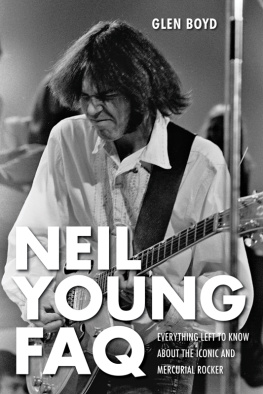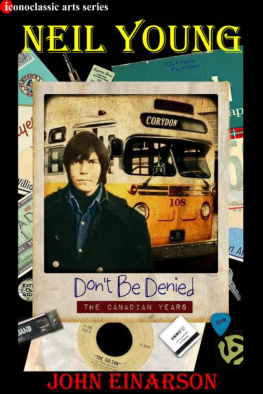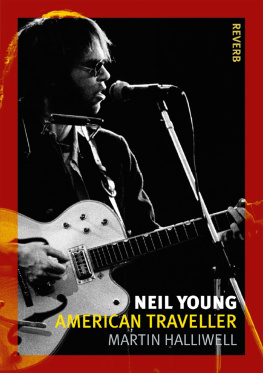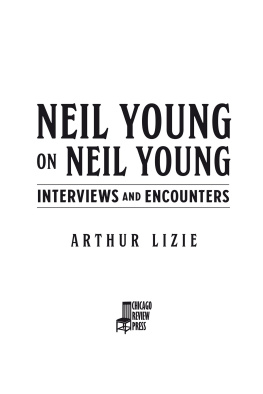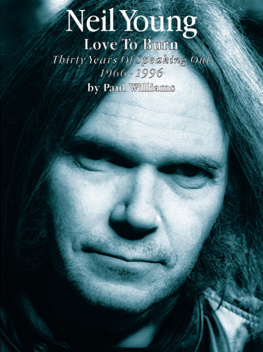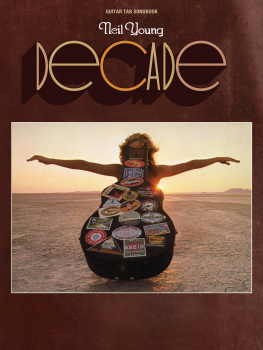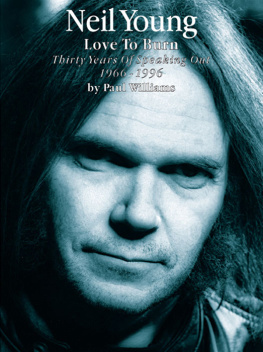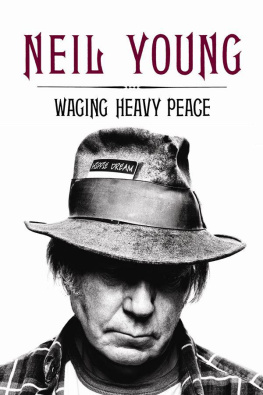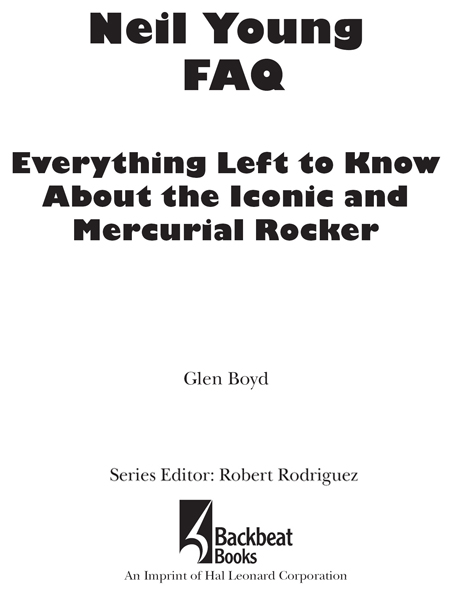
Copyright 2012 by Glen Boyd
All rights reserved. No part of this book may be reproduced in any form, without written permission, except by a newspaper or magazine reviewer who wishes to quote brief passages in connection with a review.
Published in 2012 by Backbeat Books
An Imprint of Hal Leonard Corporation
7777 West Bluemound Road
Milwaukee, WI 53213
Trade Book Division Editorial Offices
33 Plymouth St., Montclair, NJ 07042
The FAQ series was conceived by Robert Rodriguez and developed with Stuart Shea.
Book design by Snow Creative Services
Library of Congress Cataloging-in-Publication Data
Boyd, Glen.
Neil Young FAQ: everything left to know about the iconic and mercurial rocker / Glen Boyd.
p. cm.
Includes .
1. Young, Neil, 1945 2. Rock musicians--Miscellanea. I. Title. II. Title: Niel Young frequently asked questions.
ML420.Y75B69 2012
782.42166092dc23
[B]
2011047487
www.backbeatbooks.com
This book is lovingly dedicated to Dorothea Miss Moo Mootafes, who recognized and encouraged my writing talent even as I likely put several gray hairs on her head. Putting up with my antics back then alone qualifies Miss Moo for sainthood. The fact that she somehow saw a potential writer in an otherwise hell-raising teenager obsessed with rock n roll was probably the first event in my young life that eventually made a book like this possible.
So, Miss Moo, this is for you.
Id also like to dedicate this to my grandma, Theresa Nana Guyll, who took me to my first Neil Young concert (actually it was a CSN&Y show) as a thirteen-year-old boy. God bless you, Nana, and I hope that they have earplugs in heaven.
Contents
F or many of us, Neil Youngs music has provided the soundtrack to our lives for almost as long as we can remember.
I cant say exactly when Youngs music began to seep deep into my consciousness. But looking back on it now some forty years on, I can still vividly recall the exact moment when the spark of Youngs music first began to flicker and burn. It all began on the morning of May 5, 1970.
The day before, on a college campus in Kent, Ohio, four students had been killed by the National Guard while protesting against the Vietnam War.
I was in the third grade at the time and couldnt really comprehend much about the world events swirling about us. As I walked into class that day, my third-grade teacher was deeply troubled and shaking her head as she stared at the front page of the days paper.
This is awful, she declared as she gestured toward the large photo across the top of the page. As I focused on the photo, I wasnt sure what I was looking at. It seemed to be a dead person on the ground, with a girl crying while kneeling before the bodyher arms flung wide open and what appeared to be blood streaming down the pavement.
I had never seen a picture of a dead person.
This is awful. Printing a picture like this on the front page where children can see it?, the teacher intoned as my nine-year-old eyes stared, puzzled by the image.
Unknown to me at the time, immediately after the Kent State shooting (sometimes referred to as the Kent Massacre) on May 4, 1970, Neil Young composed the song Ohio after looking at photos appearing in Life magazine and then taking a walk in the woods. Crosby, Stills, Nash, and Young went into the studio and recorded the song, which was released to radio stations shortly after the killings. Soon, the lyrics Four dead in Ohio became an anthem for a generation. In some parts of the country, the song was banned from playlists because of its antiwar and anti-Nixon sentiments.
Some years later, it would become widely known that Ohio referred to the Kent State shootings, with the lyrics Four dead in Ohio evoking that Pulitzer-winning image I had inadvertently seen as a young boy. But what really struck me was how the teacher had been most concerned about the printing of the photo in a family newspaper, rather than the events surrounding that tragic day in U.S. history.
David Crosby once said that Young calling Nixons name out in the Ohio lyrics was the bravest thing I ever heard. Crosby noted that at the time, it seemed like those who stood up to Nixon, like those at Kent State, were shot. Neil Young did not seem scared at all, Crosby said.
And it is Neil Youngs fearlessness to sing truth to power that I have come to admire most. Which is not to diminish my love in following his concerts, collecting his music, blogging about him, and perhaps most importantly, the camaraderie shared with fellow fans. My life is filled with these fond memories of Youngs music, as I go on my very own journey through the past.
Like back to Woodstock in August 1969. No, I wasnt actually there on that culturally historic weekend on a farm in upstate New York. But my best friends sister had the triple-disc album of the Woodstock film soundtrack, and I used to listen to it on her Dads old hi-fi stereomuch to his dismay.
Or back to our very first albumCrosby, Stills, Nash, and Youngs 1971 live double album 4 Way Street. The between-song concert banter and camaraderie among the four struck me at once as clever, passionate, and humorous.
Or maybe it was back when AM top forty radio was playing Heart of Gold in 1972. I had never been from Hollywood to Redwood, of course. But a drive up the California coastal highway sounded kind of cool while growing up far away on the other side of the country by the Atlantic Ocean.
Or possibly it was my first giant, outdoor stadium Crosby, Stills, Nash, and Young concerton a blazing hot day in the summer of 1974. I was only thirteen years old at the time, but looking back, that day seems to have made quite an impression on me. Were all of those peace and love folks really the hippies that my parents feared so much?
But what is it about Neil Young and his music that so many miss that we fans seem to see and hear and feel?
In the parlance of our times, its complicated to say what exactly drew us to Youngs music. It seems more than just the warm, heartfelt, enigmatic, poetic lyrics. More than just the strange and often haunting vocal phrasings. More than just the gentle, folkie acoustic side, contrasted by the equally raging, wailing electric side.
The passion among Youngs diehard fanssometimes known as Rustiesis really what makes following his music such a joy and pleasure.
Rarely will you find as diverse a group of fans so united in their appreciation and celebration of an artist. Of course, Young is not just any artist but one of the most influential singer-songwriters ever to emerge from North America. Combining the lyrical complexity of Bob Dylans songwriting and the emotional drama of a Bruce Springsteen concert, Young is truly one of last remaining giants of the twentieth century to still be as relevant and compelling today as he was forty years ago.
Full disclosure here. When author (and fellow music blogger) Glen Boyd asked me to help out on this book by suggesting some topic sections, proof chapters, and fact check them as he churned them out, as well as provide some materials, I was a bit hesitant. Not that I thought a Neil Young FAQ was a bad idea or anything. It was just thinking about the daunting task of trying to catalog the virtually uncategorizable Neil Young.
But I can say after watching Boyds vision to comprehensively document Youngs forty-plus-year career come togetherall the while juggling all of the other challenges that come with following this rock-n-roll scene on a daily basisNeil Young FAQ will hopefully be an essential reference book in your own music library. And just maybe it will provide some clues to unlocking the mysteries of Youngs vast canon of work over some five decades and counting.
Next page
